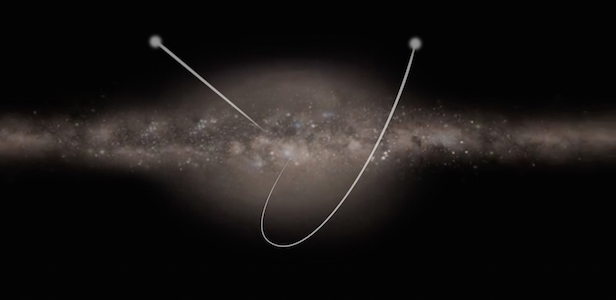ESA spacecraft observes stars ‘running away’ from our galaxy
Using Gaia’s artificial brain, the paths of six hypervelocity stars have been deduced

An artist’s impression showing two stars speeding away from the galactic centre to the Milky Way’s outskirts. Image credit: ESA
The European Space Agency’s (ESA) Gaia satellite has singled out six stars speeding around Milky Way from its centre and to the edge of its disc. By mimicking a human brain, the mission could provide vital information about the evolution of our Milky Way, and its hidden regions.
On a clear night sky, and particularly during the summer and winter, you will be able to catch the dimly-lit Milky Way spanning across the sky. This misty stretch of light is home to over 100 billion stars, and the majority lie along the galactic disc. In the centre of this disc is where supermassive black hole Sagittarius A*, an estimated 4.5 million times the mass of the Sun. Above and below this bulge is the halo, where the galaxy’s oldest stars sit.
All of this stellar matter is in constant motion, even our Sun orbits the galactic bulge at a speed of 220 kilometres per second. There are a variety of stellar velocities in the Milky Way, and the average speed in the halo is roughly 150 kilometres per second. But there are some stars that whizz around at incredibly high speeds.
This class of speedy stars, called hypervelocity stars, was discovered over a decade ago, travelling at a few hundred kilometres per second. It is believed that they originate from close stellar encounters, runaway from a supernova explosions or interactions with the supermassive black hole.
In 2015, a hypervelocity star called US 708, was discovered. This star was pushed away from a supernova explosion so fast, scientists recorded a speed of 1,200 kilometres per second. This speed will cause the star to eventually escape the galactic halo, and this is a similar phenomenon Gaia has been tracking with six different hypervelocity stars.
“These hypervelocity stars are extremely important to study the overall structure of our Milky Way,” says Elena Maria Rossi from Leiden University in the Netherlands, who presented the discovery of the six new stars at the European Week of Astronomy and Space.
“These are stars that have travelled great distances through the Galaxy but can be traced back to its core – an area so dense and obscured by interstellar gas and dust that it is normally very difficult to observe – so they yield crucial information about the gravitational field of the Milky Way from the centre to its outskirts.”
Keep up to date with the latest space news in All About Space – available every month for just £4.99. Alternatively you can subscribe here for a fraction of the price!




